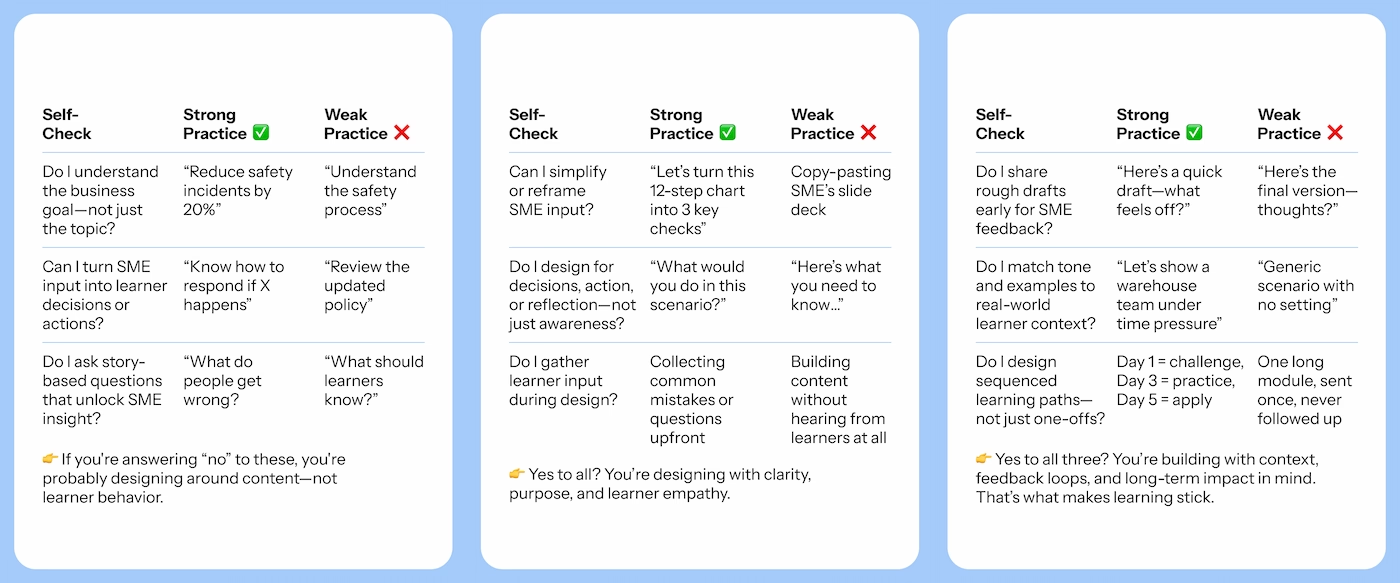
7taps
#1 Microlearning Platform
Sign up east
14-day trial. Zero cost. Full access. No credit card required.
May 6, 2025
•
Kate Udalova
Over the years, I’ve reviewed hundreds of microlearning projects and worked with more SMEs than I can count—everyone from compliance leaders to folks who’d never heard the term “instructional design.”
Here’s the one thing I’ve learned:
The success of a learning experience rarely comes down to the tool. It comes down to the collaboration.
And yet—most IDs were never really taught how to lead that collaboration.
This framework was born from the same set of questions I kept hearing from designers again and again:
So I pulled together what I’ve used, coached, and refined over time—a simple framework to help you shift from content collector to collaborative learning designer.
Before we get into techniques and tools, let’s pause.
This quick self-diagnostic will take you less than 3 minutes—and it’s worth every second.
It’s designed to help you uncover:
Let’s get into it ⤵️

Designing microlearning with SMEs isn't about gathering information—it's about making the right decisions together. That means you, the instructional designer, must lead the process with confidence and structure.
Below is a step-by-step playbook you can follow. It includes go-to questions, real-world examples, and simple ways to move from raw input to impactful learning.
Don’t start with content. Start with context.
Ask:
→ “What business problem are we trying to solve?”
→ “If nothing changes, what’s the impact on the team or company?”
→ “So what do you want people to do differently?”
Example:
SME: “We need training on the new procurement platform.”
You: “What’s not working right now?”
SME: “People submit incomplete purchase orders.”
Final outcome: “Help employees complete and submit accurate POs without errors.”
This reframing moves the SME from a feature dump to a behavior-based goal.
“What should they know?” gives you a list. “Where do they struggle?” gives you something to design around.
Ask questions like:
→ “What mistakes do you see most often?”
→ “What questions do you hear again and again?”
→ “What does a top performer do differently?”
→ “Where do people get stuck—and why?”
SMEs give you examples. Your job is to shape them into scenarios, reflections, or decisions.
Example:
SME: “Someone skipped a review step and it cost us $25k.”
You turn it into: “You’re rushing to meet a deadline. Do you skip the review?”
In 7taps, that becomes a branching scenario with time pressure and real stakes.
SMEs don’t need to know your tools. But they do need a framework.
Present a rough outline or draft—post-its, sketch, or prototype—and say:
→ “We have space for 5 moments. What matters most?”
→ “If we cut this part, what breaks?”
Example Prompt:
“We’re using 3 learning cards. Should we show a visual step-by-step or create a scenario to reinforce judgment?”
You provide structure. They bring expertise.
Generic = forgettable. Contextual = sticky.
Avoid policy-speak. Mirror real decisions, pressure, and settings.
Instead of: “Understand the compliance protocol.”
Try: “You’re 3 minutes from a shift change. What’s the first thing you check?”
Real tone makes microlearning resonate and stick.
SME sign-off doesn’t equal learner clarity. Don’t wait until it’s built.
Ask:
→ “Does this feel real to you?” (to a learner)
→ “What would you do here?” (to a peer)
If you're unsure, test two versions. Let learner data drive the next iteration.
Tip: Treat your first version like a hypothesis, not a final product.
You’ve reflected. You’ve seen the framework. Now it’s time to build the instincts that make it stick.
Start by reviewing something you’ve already built. Scan for content that tells rather than asks. Then pause and ask yourself: What is the learner supposed to decide, do, or reflect on here?
Next, begin collecting the questions that actually work in your SME conversations. Not the polite ones—the powerful ones. The ones that unlock stories, uncover friction, or spark real thinking.
Keep a swipe file. Add a note about when you used it, and what it unlocked. Over time, this becomes your personal toolkit for navigating any SME personality or project.
Don’t rely solely on what SMEs say. Watch what top performers do. If you can shadow someone for even 15 minutes, you’ll spot things no SOP can capture—workarounds, judgment calls, moments of hesitation. Those insights are gold. Design around them.
If you’re not sure how your SME conversations are going, rehearse one. Role-play with a peer. Record it. Notice where you default to content collection, where you interrupt, where you dig deeper. You’ll learn more from one playback than a dozen SME meetings.
And when you’re building? Involve learners early. Before you finalize anything, test one moment: a scenario, a reflection prompt, a checklist. Ask them: Does this feel real? Would this actually help you make a better decision? If they hesitate, revise. If they shrug, dig deeper.
Finally—keep coming back to the self-check. Not as a one-time diagnostic, but as a design mindset. Pull it out before a kickoff. Use it mid-project as a gut check. Revisit it post-launch during your retro.
This isn’t about doing more. It’s about designing with more intention, every time.
Got clarity? Great. Now open 7taps and bring it to life.
→ Log in if you’ve got an account
→ Create one for free if you don’t
Build something real—while it’s fresh. It’s super easy with 7taps!